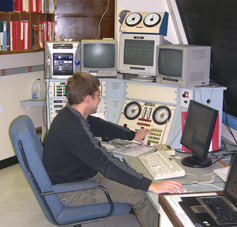
Handy Links
SLAC News Center
SLAC Today
- Subscribe
- Archives: Feb 2006-May 20, 2011
- Archives: May 23, 2011 and later
- Submit Feedback or Story Ideas
- About SLAC Today
SLAC News
Lab News
- Interactions
- Lightsources.org
- ILC NewsLine
- Int'l Science Grid This Week
- Fermilab Today
- Berkeley Lab News
- @brookhaven TODAY
- DOE Pulse
- CERN Courier
- DESY inForm
- US / LHC
SLAC Links
- Emergency
- Safety
- Policy Repository
- Site Entry Form

- Site Maps
- M & O Review
- Computing Status & Calendar
- SLAC Colloquium
- SLACspeak
- SLACspace
- SLAC Logo
- Café Menu
- Flea Market
- Web E-mail
- Marguerite Shuttle
- Discount Commuter Passes
-
Award Reporting Form
- SPIRES
- SciDoc
- Activity Groups
- Library
Stanford
Around the Bay
Imaging the Universe
 Lance Simms yawns and takes a sip of his "morning" coffee. It is 2:00 p.m., and he is slowly waking up, beginning to prepare for the long night ahead. The 26-year-old SLAC researcher and graduate student scrutinizes the checklist taped to the desk where he sits. He knows that, a few hours from now, one wrong flick of a switch could damage the multi-million-dollar machine of which he will have full command.
Lance Simms yawns and takes a sip of his "morning" coffee. It is 2:00 p.m., and he is slowly waking up, beginning to prepare for the long night ahead. The 26-year-old SLAC researcher and graduate student scrutinizes the checklist taped to the desk where he sits. He knows that, a few hours from now, one wrong flick of a switch could damage the multi-million-dollar machine of which he will have full command.
After eating "breakfast" and doing some final organization, Simms powers up this beast, one of Kitt Peak National Observatory's mammoth telescopes. When he tells it where to focus its six and a half-foot-wide eye, the photon-collecting "light bucket" whines, protesting the command to stare at a big, white spot inside its protective dome.
Simms runs this drill as the sun sets in Tucson, Arizona. The test ensures every part of the telescope is working properly, especially the new digital imager Simms attached to it. Only after these trials can the grad student unleash the telescope and his experimental picture-making device to catch the light of distant stars.
This imager, Simms says, could revolutionize how astronomers use telescopes to capture pictures of stars and galaxies, and it might one-day improve digital photography in the commercial world—if it lives up to its potential.
Simms explains that his device is basically like a mega-pixel chip for a digital camera, only much larger and more sensitive. It is not, however, the standard kind of imaging tool, called a charge-coupled device (CCD), that comes in the best digital cameras or the kind astronomers usually attach to ground telescopes. Instead, it is a state-of-the-art SiPIN hybrid CMOS, or Complimentary Metal-Oxide-Semiconductor detector.
These detectors are called hybrids because they consist of two layers that are independently optimized and then stacked to form a single imager. The term SiPIN refers to one layer, an array of Silicon Positive-Intrinsic-Negative photodiodes that are used to collect light and convert it into electrical charge. The term CMOS refers to the other layer, a multiplexer circuit that is used to sense this charge in each one of these photodiodes. The resulting imager, Simms says, requires less power, does not get as hot, and can process light more quickly into digital pictures than CCDs.
SLAC's Kirk Gilmore wishes to exploit this imager's speed for the Large Synoptic Survey Telescope (LSST)—a new ground-based telescope that will survey the sky and have an eye 16 times the size of the one Simms now uses. The LSST is set to see first light in 2014.
Gilmore, the telescope's camera manager, assesses imaging technology that the LSST will use. He says the new telescope could benefit from the CMOS imager's speed when tracking guide stars because they can evaluate the stars' changes in celestial position every thousandth of a second. These positional changes are mostly due to atmospheric disturbances.
Continually updating a guide star's location in the telescope's computer database will be essential for maintaining crisp images. The observing program is designed to take relatively brief, 15-second exposures of the space objects. Any mistake in steering the LSST during these short exposures could smear images and ruin the data.
In Tucson, twilight has ended. It is time for Simms to command this Kitt Peak telescope to turn its eye on a star 23 trillion miles away.
He focuses on the telescope console—one superficially resembling that of a space shuttle control panel. After dialing in the coordinates of his target star, he takes another swig of coffee.
It's going to be another long night.
—Ashley Yeager, SLAC Today, January 9, 2007
Above image: Lance Simms at the controls of the Kitt Peak 2.1 Meter Telescope.